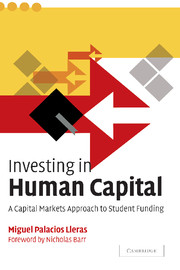Book contents
- Frontmatter
- Contents
- List of figures
- List of tables
- Foreword
- Acknowledgments
- Introduction
- Part I The problem of financing education
- Part II Equity-like investments to finance education
- Part III Implementing human capital contracts
- 8 Hurdles in the implementation of human capital contracts
- 9 Lessons from the implementation of income-contingent loans
- 10 Government-driven implementation of human capital contracts
- 11 Conclusion
- Appendix A Valuation of human capital contracts
- Appendix B Using human capital options to value income-contingent loans
- Appendix C Features of human capital contracts, income-contingent loans, and traditional mortgage-type loans
- Appendix D A developing country study
- Notes
- References
- Index
9 - Lessons from the implementation of income-contingent loans
Published online by Cambridge University Press: 08 January 2010
- Frontmatter
- Contents
- List of figures
- List of tables
- Foreword
- Acknowledgments
- Introduction
- Part I The problem of financing education
- Part II Equity-like investments to finance education
- Part III Implementing human capital contracts
- 8 Hurdles in the implementation of human capital contracts
- 9 Lessons from the implementation of income-contingent loans
- 10 Government-driven implementation of human capital contracts
- 11 Conclusion
- Appendix A Valuation of human capital contracts
- Appendix B Using human capital options to value income-contingent loans
- Appendix C Features of human capital contracts, income-contingent loans, and traditional mortgage-type loans
- Appendix D A developing country study
- Notes
- References
- Index
Summary
The years since 1970 have seen several attempts to introduce income-contingent schemes (ICLs) in the financing of education, and several such schemes have now been implemented successfully in different countries. As we saw in chapter 4, ICLs are loans in which students pay a percentage of their income until they repay the loan and accrued interest, or until a maximum repayment period has been reached. They differ from human capital contracts (HCCs), as in an HCC students pay for a fixed period of time, regardless of the amount repaid. In chapter 6, we discussed how ICLs were an income-contingent repayment mechanism and therefore offered some of the same advantages of HCCs. We also discussed in that chapter how HCCs displayed some additional attributes that ICLs did not have. Chapter 7 was devoted to showing the relationship between HCCs and ICLs through the introduction of human capital options (HCOs). Now we shall look for lessons in the implementation of ICLs that can be used to improve the possibilities of success in implementing HCCs.
This chapter will look in detail at the program Yale started in 1971 and at that implemented in Australia in 1989. In addition, a brief description is provided of other income-contingent programs. The lessons that can be drawn from these two cases are relevant for HCCs because ICLs and HCCs share the income-contingent feature.
- Type
- Chapter
- Information
- Investing in Human CapitalA Capital Markets Approach to Student Funding, pp. 123 - 143Publisher: Cambridge University PressPrint publication year: 2004



